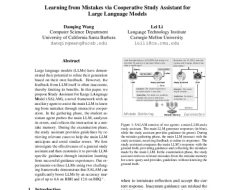The Gist
- Future predictions. The future of generative AI suggests a gradual, yet transformative impact across multiple sectors by 2024.
- Risk assessment. Risks of generative AI include potential job disruptions but also offer enhanced productivity and innovation.
- Tech evolution. Generative AI’s role in automating and enhancing tasks like call center operations and RPA signifies a tech paradigm shift.
Despite the remarkable strides made in generative AI, it has not been a disruptive force, leading to intriguing speculations about the future of generative AI. This may be partly because the technology is still in its early phases of adoption and integration into various sectors.
In the meantime, the economy has demonstrated resilience and robust growth, maintaining low unemployment levels even amidst high interest rates. This suggests that the current economic environment is effectively absorbing the technological advancements without significant negative repercussions on job markets.
Moreover, the nature of generative AI as it stands today is predominantly collaborative rather than fully autonomous. Instead of replacing human roles, it functions more as a copilot, augmenting and enhancing human capabilities.

Despite this, there will still likely be disruption. This is a natural result of any transformative technology. After all, in the early days of the internet, it had a wide-ranging impact on brick-and-mortar retailers, travel agencies, media and entertainment, traditional telecommunications and advertising.
The same will be the case with generative AI. This is also likely to start happening in 2024.
The Future of Generative AI: Call Center Business
The traditional call center industry generally involves operations with a large number of employees. They usually operate on a 24/7 basis and are focused on metrics like call handling time, customer satisfaction scores and resolution rates.
The size of the global call center market is about $31 billion and is expected to grow at 11% per year over the next decade.
However, this may prove wildly optimistic. Generative AI is already adept at automating tier-1 and even tier-2 support. The technology can also be fine-tuned to handle more complex matters by processing internal information, such as about products and services. Generative AI can do all this with high levels of personalization and in natural-sounding language.
Then there are the advances in multimodal capabilities. In other words, generative AI can speak fluently across multiple modalities.
In the next few years, this will extend to video. There will be immersive avatars that will be human-like and easily handle any type of customer question.
Related Article: Generative AI Will Reduce 30% of Customer Service and Support Agents
The Future of Generative AI: Robotic Process Automation (RPA)
Robotic Process Automation (RPA) is a technology used for automating routine and repetitive tasks in business processes. It involves the use of software robots, or “bots,” that can mimic human actions to perform tasks such as data entry, processing transactions and managing data. These bots can interact with different software systems, just like a human user would, but with greater speed, accuracy and consistency.
RPA typically offers a quick return on investment, often realized within months of implementation. This is due to the cumulative impact of cost savings, productivity gains and improved operational efficiency.
Despite this, generative AI presents a compelling alternative to RPA. One significant advantage of generative AI is its ability to learn and adapt over time. While RPA requires a well-defined, structured process to function effectively, generative AI can handle ambiguity and variability in data and processes. This adaptability is particularly valuable in scenarios where processes are not entirely rule-based or where exceptions frequently occur.
Furthermore, generative AI can manage and interpret large volumes of unstructured data, such as text, images and audio, which RPA typically cannot handle. This capability is crucial in today’s data-driven business environment, where the ability to quickly process and extract insights from diverse data sources can provide a significant competitive advantage.
Another area where generative AI outshines RPA is in the creation and maintenance of automation scripts. RPA often requires a sophisticated understanding of scripting languages and a considerable investment in bot development and maintenance. Generative AI, on the other hand, can learn and generate the necessary scripts or actions based on training data and natural language prompts. This reduces the reliance on specialized programming skills and can significantly lower the barrier to implementing automation solutions.
Moreover, generative AI addresses the challenge of bot sprawl — the proliferation of numerous RPA bots that can become difficult to manage and integrate. Generative AI systems can provide more centralized, cohesive solutions that are easier to manage and scale, thus avoiding the complexities associated with maintaining a large number of individual RPA bots.
In light of all this, it should be no surprise that RPA vendors are aggressively adopting generative AI. However, it could be challenging to rework legacy systems. Ultimately, this can present opportunities for startups to upend the category.
Related Article: The Origins, Growth and Challenges of Robotic Process Automation (RPA)
The Future of Generative AI: Database Administration
A Database Administrator (DBA) plays a crucial role in managing and overseeing the performance, integrity and security of databases in an organization. They are responsible for ensuring that data remains consistent, is clearly defined, accessible and secure. A DBA’s duties typically include installing and upgrading database servers and application tools, modifying database structures as necessary, implementing security measures and maintaining backup and recovery policies to prevent data loss. They are also involved in capacity planning, performance monitoring and tuning of databases.
As of 2022, there were approximately 149,300 DBAs and architects employed in the United States. The job market for these professionals is projected to grow by 8% from 2022 to 2032, which is faster than the average for all occupations.
Yet this is a career path you may want to rethink. For the most part, generative AI is good at handling the complexities of scripts for SQL and other operations for database administration. The technology is particularly good at pattern recognition, which is at the heart of the process. Even ChatGPT — which costs only $20 a month — can handle complex operations.
But DBAs are just one of the areas that code-generation systems will have a major impact on. Others include common tasks for junior programmers as well as configuration and maintenance for cloud systems like AWS, Azure and Google Cloud.
Related Article: Good Customer Data Fuels AI Revolution in Customer Experience Management
Conclusion: Envisioning a Future Shaped by Generative AI Across Diverse Industries
Heading into 2024, we are witnessing a paradigm shift across various job sectors and industries, driven by the advent of generative AI, which heralds the future of generative AI as a transformative force. This shift is reminiscent of the early internet era’s transformative impact.
While we’ve explored a few key areas likely to be affected, it’s important to anticipate that the ripple effects of generative AI will extend much further, bringing considerable changes across a wide range of fields.
Learn how you can join our contributor community.




